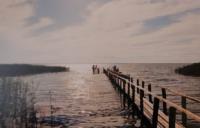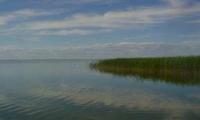You are here
Lake Sultankeldy in Korgalzhyn Reserve.


Birds on lakes of Korgalzhyn Nature Reserve.
"In the valley between the mountains under the soaring
agle
Glistens thick blue
water,
Cheerful schools of playing fish
Shimmer blue in the water
silver."
"Hello, Caucasus." Zhambyl Zhabaev.
Lakes of Korgalzhyn Nature Reserve.
Lake Sultankeldy is located at an altitude of 309 meters above sea level, located in north of Kazakh small hills, at bottom of Tengiz-Korgalzhyn depression, on territory of the Korgalzhyn natural park, in Korgalyzh district in southwest of Akmola region.
Lake Sultankeldy is part of the Tengiz-Korgalzhyn lakes system. The area of Lake Sultankeldy is 43.42 square kilometers. The length of the lake's coastline reaches 32.76 kilometers. The length of the lake is 13.5 kilometers, the greatest width of the lake is 6 kilometers.
The maximum depth of the lake does not exceed 2.5 - 3 m. The average depth of Lake Sultakeldy is 1.6 meters. In 1940, the lake was completely dry (Posokhova, 1949). The mineralization of water in the lake varies in different parts of the lake: near the mouth of the Nura River in the southern part, the water is fresh, in other parts of the lake it is brackish.
The range of changes in water mineralization is from 0.7 to 3.5 g/l. Total mineralization of water – from 0.648 to 2.486 g/l. The chemical composition of water is sodium chloride. The lake is rich in fish (crucian carp, mirror carp, pike, tench, ide, perch, etc.).
The coast of the lake is home to swans, osprey and other birds. Wild boar can be found in the reeds. The sharp-faced frog and the green toad live on the lake and in the floodplain of Nura. The Nura River flows into the southern part of Lake Sultankeldy; the river first passes through Lake Tabankyzy.
The Nura River flows from the southwestern part of the lake through the Alkym channel and after 6.5 kilometers flows into the southeastern part of Lake Kokay. In the central, western part of the lake there is the Bolshoi Koksal Bay.
In the northwestern part of the lake there is a cordon called Nefterazvedka. In the south-eastern part of the lake there is a cordon and a base for ornithologists “Karazhar”, here there are guest houses, summer houses, and a large dining room.
In the mid-50s of the last century there was a small village here, 1 kilometer to the south there was a fishing crew. In the southwestern part of the lake there is a small lake, Big Karakol, and in the southeast, Lake Taban.
In the eastern part of the lake, 730 meters away, there is the Tuz salt marsh. In 1976, the Tengiz-Kurgalzhyn system of lakes, including Lake Eskeldy, was included in the list of wetlands of international importance subject to the Ramsar Convention.
On the lake there is a kingdom of reeds and cattails, their thickets occupy 70 - 80% of the water surface. On Lake Sultankeldy, small invertebrate animals living in the water column (zoo-plankton) or on the bottom (zoobenthos) are of great food value for fish and birds.
The zoobenthos of the lake is characterized by the presence of a large number of larvae of various insects - dragonflies, mayflies, bedbugs, caddis flies, butterflies, beetles, flies and others, as well as mollusks and small crustaceans.
Zooplankton is relatively poor and is represented mainly by rotifers, cladocerans and copepods. Hydrobionts attach to submerged vegetation, which allows dabbling ducks to feed not only in shallow water, but also in deep places. This is especially important for molting birds.
Breeding birds are the most numerous group of birds on Lake Eskeldy. Along with typical representatives of the middle latitudes (coot, mallard, greylag goose, lapwing, black-headed gull, hooded crow, skylark), such southerners as flamingo, Dalmatian pelican, white heron, sea pigeon, black-headed gull, stilt, sea and sea lark nest in the reserve. Asian (Caspian) plover, mountain linnet, gall bunting, etc.
Geographic coordinates of Lake Sultankeldy: N50°29'37 E69°30'33
Authority:
Alexander Petrov.
"Reserves of Central Asia and Kazakhstan." Publishing house "Mysl". 1990 Edited by V.E. Sokolova, E.E. Syroechkovsky.
Photos by:
Alexander Petrov.







